This post may contain affiliate links. Please read our disclosure policy.
Learn how to make classic puff pastry from scratch with an easy to follow video tutorial! My classic puff pastry makes the flakiest, most buttery pastry imaginable. The results will be better than store-bought!
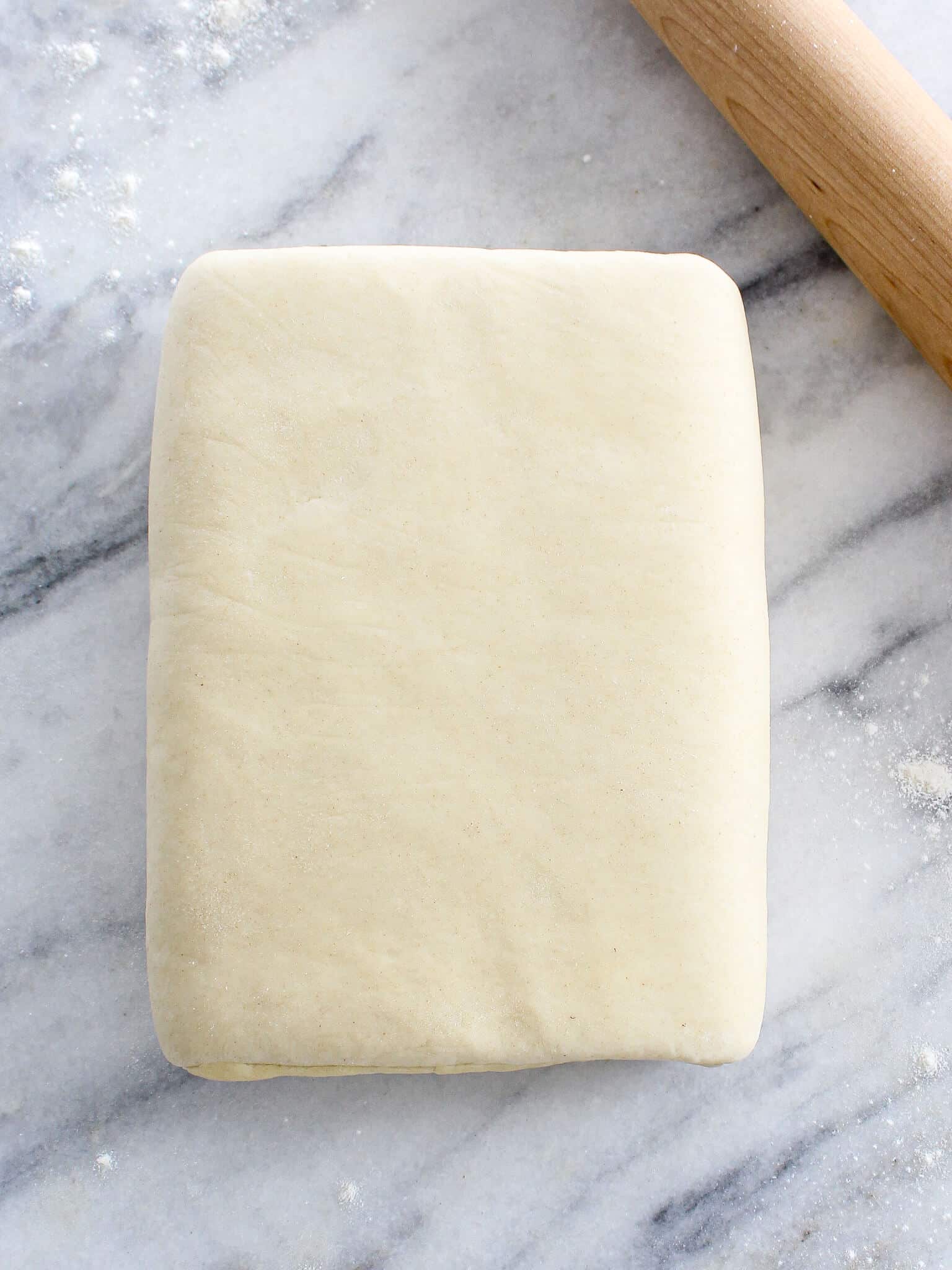
Use this classic puff pastry recipe by a professional pastry chef to make all your flaky, buttery dreams come true! You could use it to make a puff pastry fruit tart, cinnamon sugar twists, palmiers, this baked pear recipe, or even this individual beef wellington recipe!
I don’t often do this these days but indulge me with a story. I’ll get into the nitty gritty of puff pastry later.
One of the casualties of COVID-19 was my culinary school. The International Culinary Center shutters its doors this month. The announcement came when the majority of my industry was unemployed including me. I can’t even begin to tell you how sad it made me — like a little piece of me was gone.
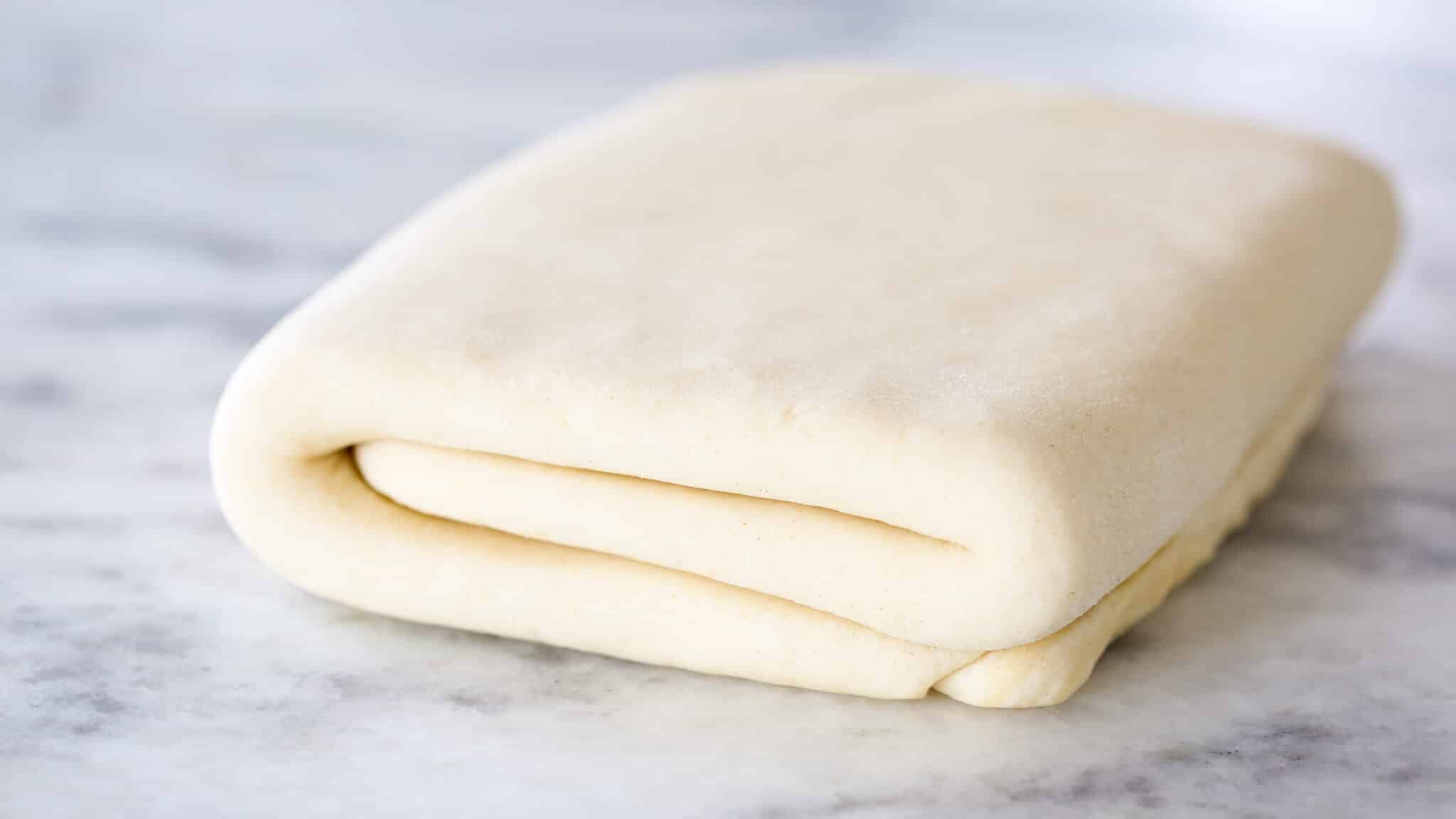
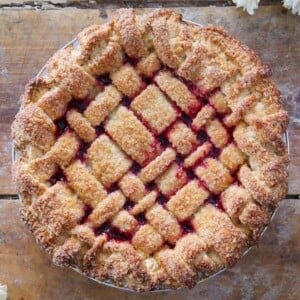
ICC felt like home in a way. It was why I moved to NYC 6 years ago and where I met my best friend in the whole world. It is where Robin Hom taught me knife skills on a cutting board in his office in preparation of me training as a savory line cook. I was nervous that I didn’t know anything beyond pastry and he wanted to help. (These were they types of wonderful people who worked at ICC. They went above and beyond for the love of the industry.)
It is where I hired all of my most successful cooks and sous-chefs (I’m looking at you Mara and Abigail?). It is because of ICC that I am a pastry chef and that I was so successful so quickly. The team of chefs and staff rally behind their graduates. They gave me support long after graduation.
A few months ago I reached out and, much to my surprise and delight, I was able to buy their dough sheeter. It’s not the newest or the shiniest piece of equipment but that dough sheeter helped me start my pie selling venture.
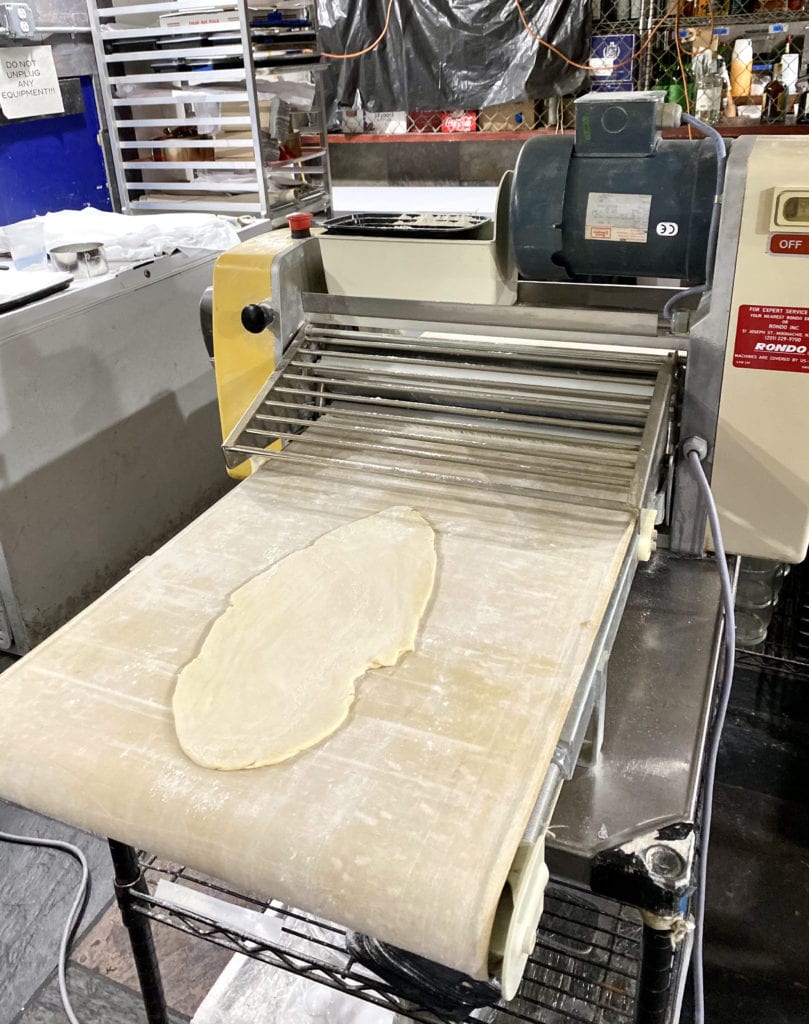
I can tell you right now that rolling 500 pie crusts by hand would have been the death of me. Mara (my sous chef and fellow ICC grad) and I set up the dough sheeter in the basement of Restaurant Marc Forgione, where Chef Marc installed a special plug just for us, and we spent countless hours learning the machine and rolling more pie dough than either of us had ever even seen! We both give it a loving pat every time we walk by, and I can’t speak for her, but it makes me smile in remembrance of my time at ICC and all the wonderful people who are in my life because of that school. I will hold ICC in my heart forever.
I suppose I should tie that story into this puff pastry! ? But I’m not going to. Call me lazy.
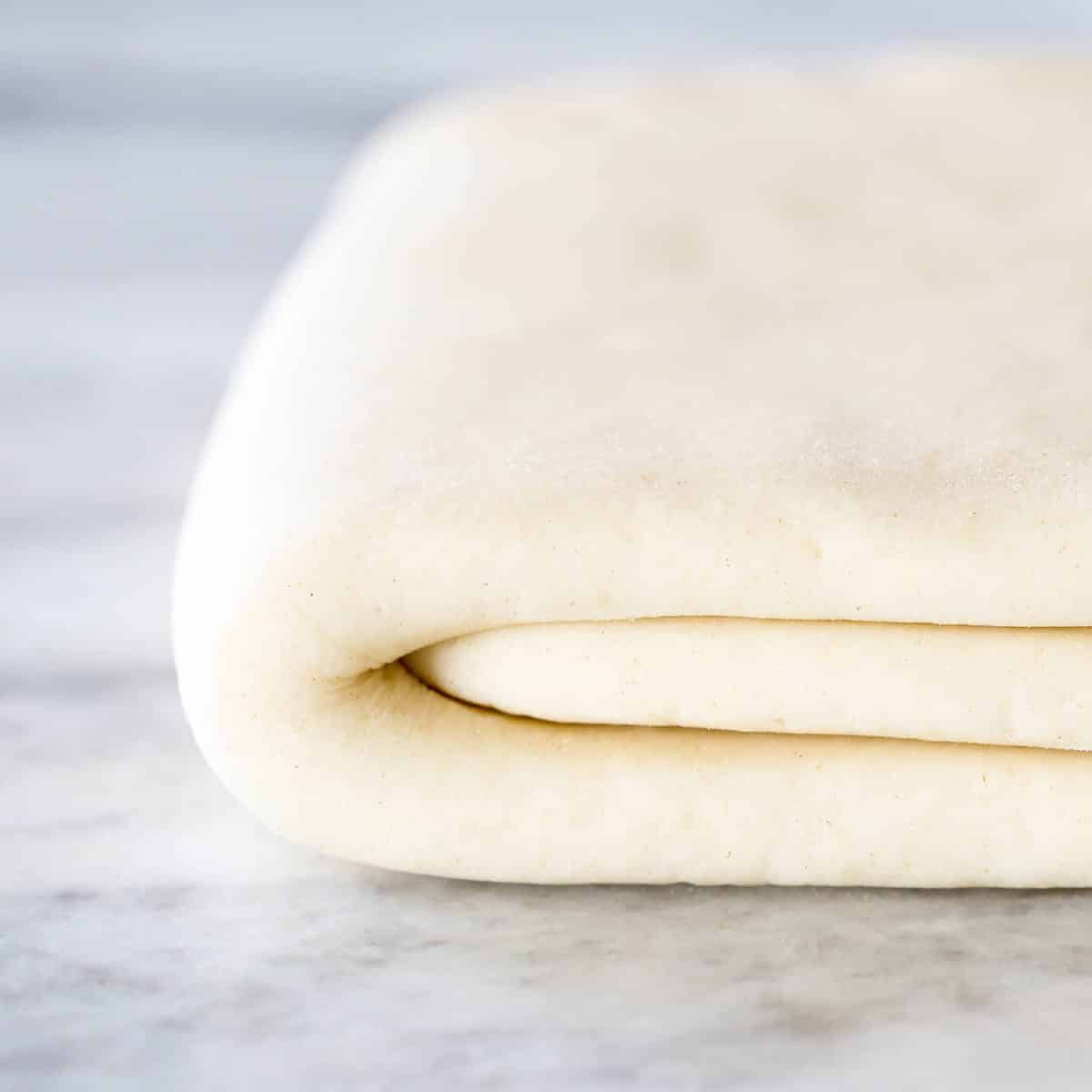
Keys to Classic Puff Pastry Success
Most of the same techniques and rules apply to classic puff pastry as for inverse puff pastry, but in this case the butter packet (beurrage) goes inside the dough packet (détrempe), and then the folding, chilling, rolling begins!
Lamination is what makes all those beautiful flakey layers! Through a series of folds you create individual layers of butter and pastry dough. When the puff pastry hits the hot oven the butter melts, the water in the butter evaporates and creates steam, and that steam pushes the pastry layers apart. Voilà! Layered, buttery awesomeness.
So, your deductive powers are right, and all that flakiness is hinging on two things: creating those layers and maintaining them.
You create those layers by performing a series of folds (or “turns”). There are two types of folds in the pastry world: single (envelope) folds or double (book) folds. The total number and types of folds will determine how many layers your resulting puff pastry has. The same recipe with a different combination of folds will yield a drastically different result!
For puff pastry I like to use 6 single folds done in batches of two.
Never try to do more than 2 turns at a time (especially with classic puff pastry). The gluten in the dough will contract and make getting the pastry thin enough difficult or impossible, and the butter will get too soft and warm and will work into the dough rather than maintain its integrity. Integrity in pastry is just as important as in life. You heard it here first.
Both creating and maintaining the layers depends on keeping the butter cold yet pliable. If you roll cold butter, it will break and sad, uneven layers will result; however, if you do not chill your dough, the dough will become unyielding and uncooperative.
The most important thing in pastry, and this especially holds true with laminated doughs, is to pay attention to your dough. You need to know it intimately, understand its struggles and frustrations, so that you can react immediately and give it what it needs. Dough can never be forced, but you can learn the tricks to controlling it so that it remains cooperative and happy. If the dough is shrinking, chill it letting it relax in the refrigerator. If the butter is hard, wait or learn how to manipulate it at each stage so that it works closer to your timeline. (My video can help)
If I could distill everything into one snippet of advice, it would be: Do not rush and keep it cold and flat! If not, the lamination will suffer and then you just put all that work in for nothing. And that is truly sad. We don’t do sadness at CLF. We do butter. Loads of butter.
If you tried this recipe and loved it please leave a 🌟 star rating and let me know how it goes in the comments below. I love hearing from you; your comments make my day!

Classic Puff Pastry Blog
Ingredients
Détrempe (the dough part):
- 160 g Water cold
- 4 g White Vinegar
- 12 g Salt
- 125 g Beurre en pomade softened butter
- 15 g Sugar
- 198 g Cake Flour
- 198 g AP Flour
Beurrage (the butter part):
- 375 g Butter cold but pliable
Instructions
- Fold a piece of parchment into a 6.5-inch square and set aside.
- Combine dry ingredients for the détrempe in the bowl of a stand mixer fitted with the paddle attachment. Add the softened butter and cut in butter until no visible butter remains. Combine water and vinegar. With the mixer on low, pour in the water/vinegar mixture into the flour. Mix until a dough forms. Turn dough out onto unfloored surface and gently knead until no dry bits remain (dip your hand in cold water and moisten specific areas if needed). Press or roll into a 10 inch square and wrap in plastic wrap and chill 30 minutes.
- Right before combining the beurrage and détrempe beat butter with a rolling pin to soften. You want it to be cold but pliable. Place inside parchment square and roll it flat, making sure to get it into all the corners. Work quickly so that the butter is still cold yet pliable.
- Place beurrage inside the détrempe, folding the corners of the détrempe over the beurrage and sealing with the rolling pin. Roll 18 inches x 7 inches approximately and perform an envelope fold by folding the dough like you would a piece of paper to go inside and envelope. Fold the top third down and then overlapping with the bottom third. Roll out to 18 x7 inches and make one more envelope fold. Wrap in plastic wrap and chill for 30 minutes.
- Repeat sets twice more, chilling 30 minutes in between sets, for a total of 6 single turns.
- Chill at least 2 hours or overnight. Overnight is best!
- Roll 1/8 inch thick, chilling as needed to prevent the dough from getting too warm or shrinking. I find it easier to roll it about the size of a baking sheet, chill and then slice the dough in half with a pizza cutter. Continue rolling one half while the other half chills and then swap them out as they warm up or start to shrink until they are both about 1/8 inch thick. You will end up with two pieces of dough the size of a baking sheet.
- Before using the dough be sure to chill it at least 30 minutes. Cut into the desired shape, dock the dough and then chill it once more before baking. Do not allow the dough to temp before baking or you will not get those nice layers.
- Bake in an oven preheated to 375°F (preferably convection).
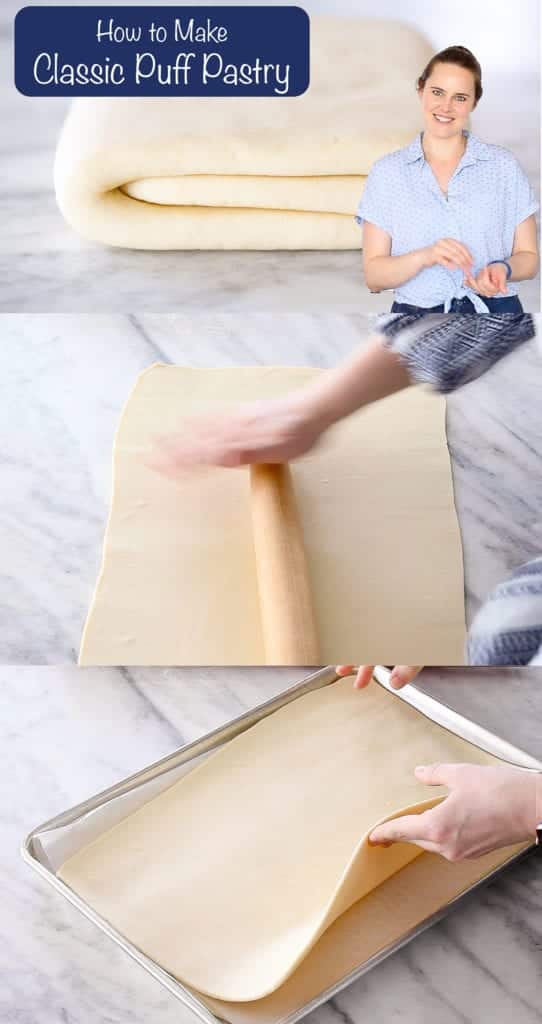

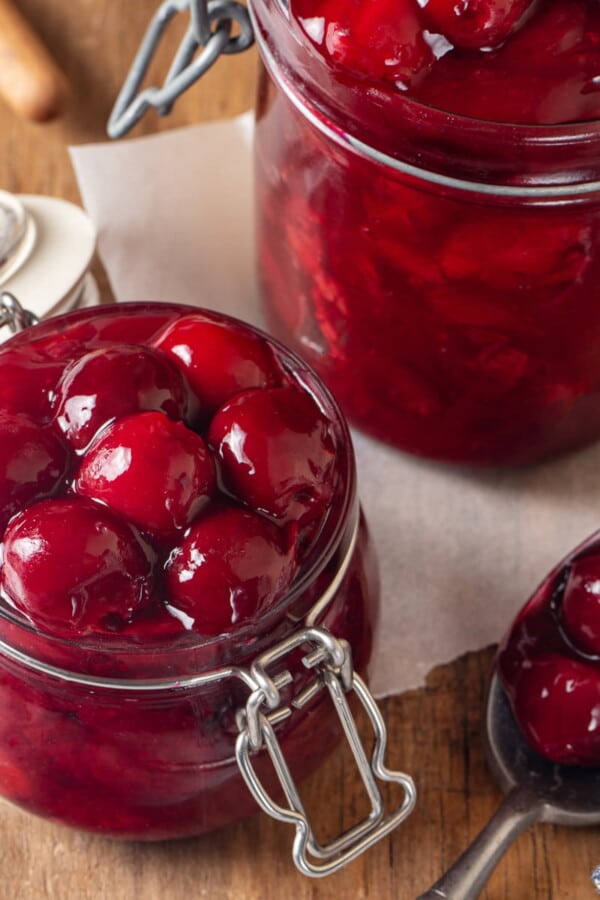
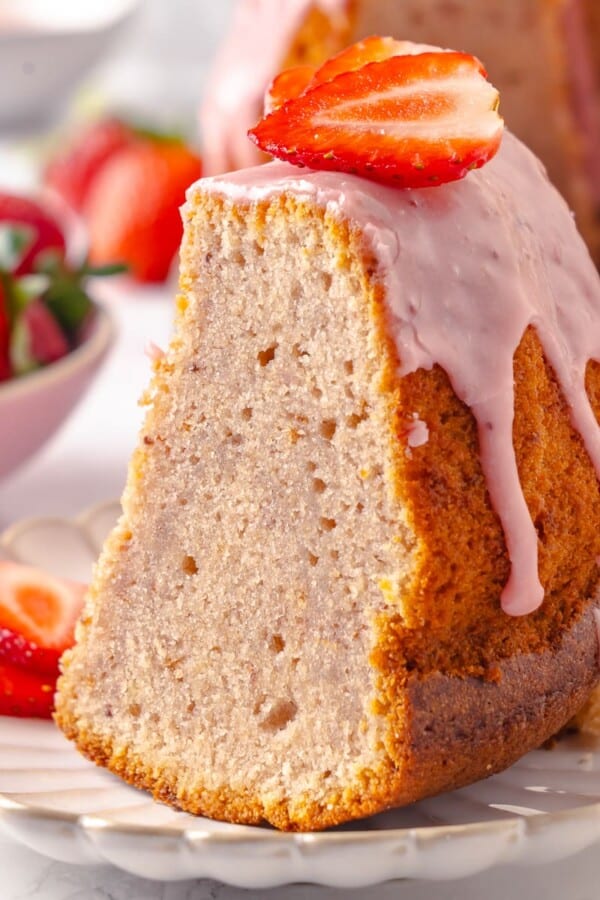












Hi, are you able to freeze the dough to use at a later time?
Hi Elora! Yes, you can always have perfect puff at the ready!
Step 1: Freeze it in sheets between parchment paper and wrap it really, really well.
Step 2: Pull out one sheet at a time whenever a need arises.
Happy baking!
Worked perfectly! Used this to make a Wellington and it was a delight!
Wow! Props to you! Beef wellington with homemade puff pastry! You are amazing!
Loved the video–so informative, but a couple of questions:
You speak of “temping” the dough. Is that to let it warm up slightly after removing it from frig before rolling so it doesn’t tear?
Previously, when making the Beurrage, I have mixed the room temp butter with a small amount of flour. Not sure of purpose, but you do not, so maybe there is no purpose??
FLOUR: some recipes call for at least part bread flour. Since it seems to me that gluten development should be restricted, I have always used AP, but I see you are using about half cake flour. That seems to me to be a great idea, so I will be doing that.
Thanks for the recipe; I am looking forward to trying it.
Hi Sandra! Fabulous questions! You nailed it on temping the dough. I do add some four to my butter during beurrage in my inverse puff pastry, which is just a slightly different approach, so that might have been the style you were following before! I definitely recommend the AP + Cake Flour lifestyle, it’s worked wonders for my puff. Can’t wait to hear what you bake up!
I don’t have a stand mixer. Can I do it all by hand.
Thanks
Hi David! Yes, you can absolutely do it all by hand. Though this video is for pie crust, this would be useful to give a look over as a way to approach mixing by hand: https://youtu.be/_kZJe2IwV2A.